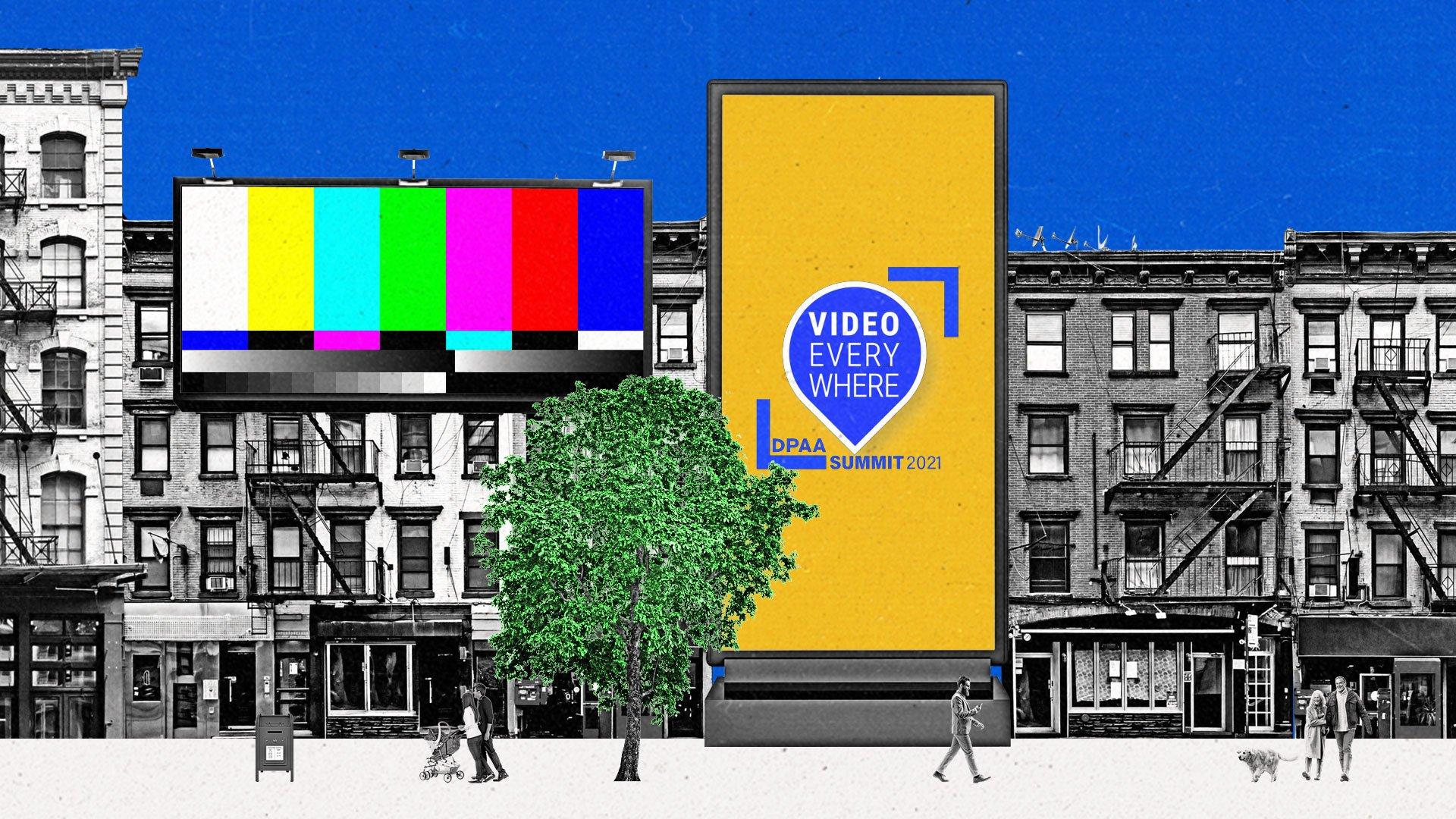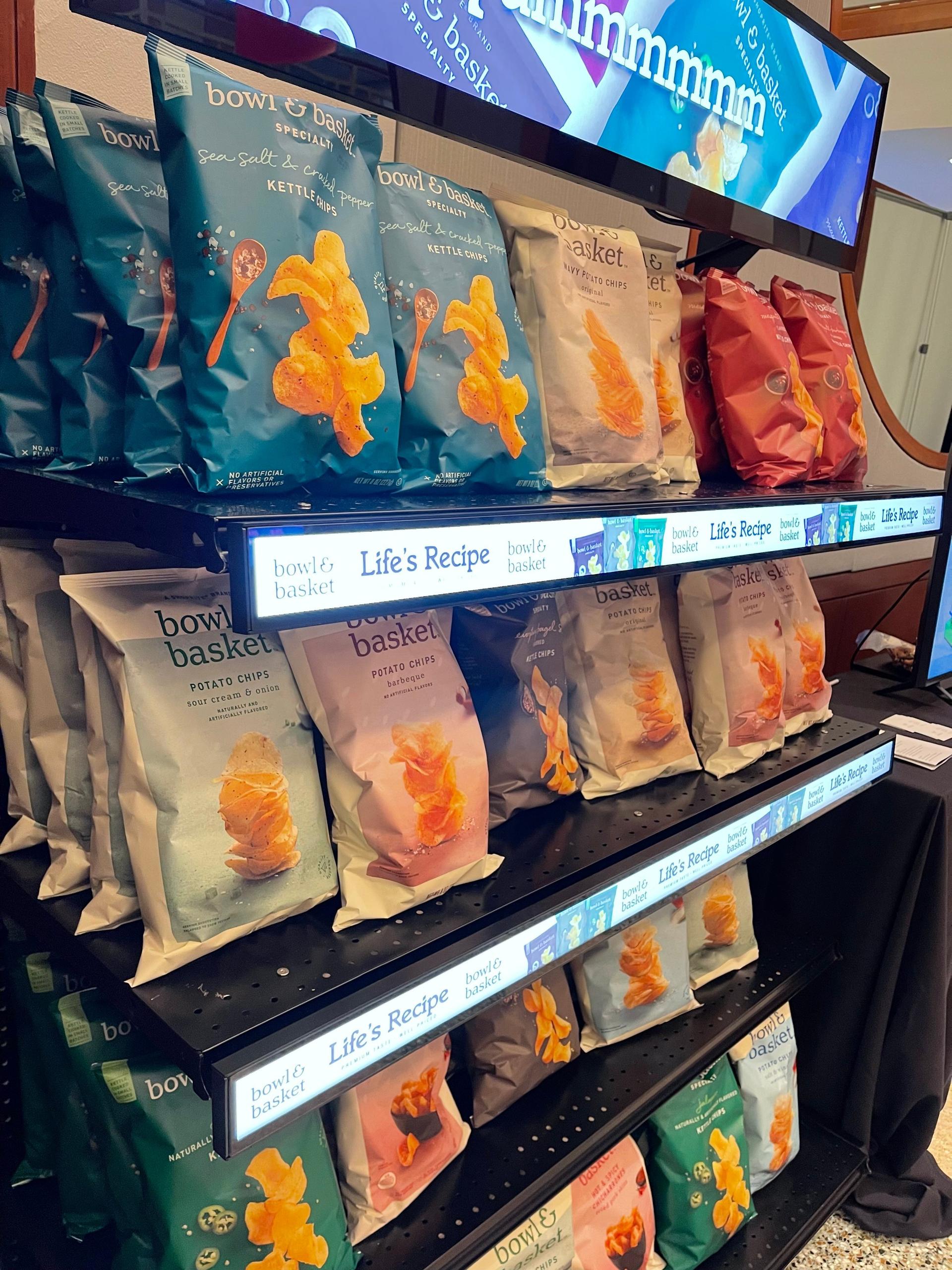From shoppable ads to screens in fridges, here’s what you missed at the DPAA’s digital-out-of-home Video Everywhere Summit

Illustration by Nick DeSantis / Getty / The Current
There was no shortage of screens at the Video Everywhere Summit in New York, an annual event held by the DPAA, a digital-out-of-home trade association.
More than 600 (vaccinated) people attended the in-person event for a glimpse of what the future of digital-out-of-home (DOOH) advertising may hold. “Humans crave connection,” Barry Frey, president and CEO of the DPAA, tells The Current. “And like in-person events, out-of-home advertising is back — stronger than ever.”
Digital-out-of-home is being closely watched by marketers because not only is it one of the fastest-growing advertising channels, it’s also one that’s in the midst of a rapid innovation phase. Indeed, one major takeaway from this week’s get-together is that the industry is just scratching the surface of what’s possible as new screen formats and environments emerge.
Digital-out-of-home, for instance, is increasingly becoming programmatic. New ideas — such as shoppable ads on digital billboards — are also taking hold. Meanwhile, retailers like Walmart, Kroger and Walgreens are partnering with DOOH companies like Cooler Screens to replace the glass doors found in their freezer aisle with large, brightly lit screens that promote products like Halo Top Ice Cream, or Michelob Ultra Beer.
“We know when the consumer opens the freezer door, what item they grab and when they checkout,” Arsen Avakian, CEO and co-founder of CoolerScreens, tells The Current. “We give brands targeting capabilities, while also putting the right message in front of the right person at the right time.”
Screens everywhere
Programmatic is becoming a key driver in DOOH’s growth, which is expected to see global ad revenues of $25 billion in 2025. The programmatic boom will be driven in large part by smaller screens — and not those found in Time Square, for instance. As a result, many of these smaller screens are getting a boost in data and targeting capabilities. GroceryTV, for example, installs cameras to capture anonymous demographic data about who is in the grocery aisle of any given store.
“The place-based digital-out-of-home footprint expanded rapidly over the past decade, often fueled by a ‘if you build it they will come’ mindset,” Rick Robinson, an OOH consultant, tells The Current. “This gave critical mass to the total U.S. screen count. In the end some venues worked, some didn't.”
In other words, DOOH is currently going through a period of rapid experimentation, but whether many of these new ad formats will capture consistent ad spend from brands is to be determined.
Looking ahead
Digital-out-of-home’s rapid growth is also prompting companies to create ad inventory from just about anything with an existing screen. Coinstar kiosks, for example, previously used their displays to inform consumers how much their loose change is worth. But after partnering with VistarMedia to also show ads on those screens, the company was able to capture $1 million in ad revenue over a six-month period.
In other instances, screens are being added in new places, such as actual shelves that hold products like potato chips or soup (see photo below).
There was no shortage of screens at the Video Everywhere Summit in New York, an annual event held by the DPAA, a digital-out-of-home trade association.
More than 600 (vaccinated) people attended the in-person event for a glimpse of what the future of digital-out-of-home (DOOH) advertising may hold. “Humans crave connection,” Barry Frey, president and CEO of the DPAA, tells The Current. “And like in-person events, out-of-home advertising is back — stronger than ever.”
Digital-out-of-home is being closely watched by marketers because not only is it one of the fastest-growing advertising channels, it’s also one that’s in the midst of a rapid innovation phase. Indeed, one major takeaway from this week’s get-together is that the industry is just scratching the surface of what’s possible as new screen formats and environments emerge.
Digital-out-of-home, for instance, is increasingly becoming programmatic. New ideas — such as shoppable ads on digital billboards — are also taking hold. Meanwhile, retailers like Walmart, Kroger and Walgreens are partnering with DOOH companies like Cooler Screens to replace the glass doors found in their freezer aisle with large, brightly lit screens that promote products like Halo Top Ice Cream, or Michelob Ultra Beer.
“We know when the consumer opens the freezer door, what item they grab and when they checkout,” Arsen Avakian, CEO and co-founder of CoolerScreens, tells The Current. “We give brands targeting capabilities, while also putting the right message in front of the right person at the right time.”
Screens everywhere
Programmatic is becoming a key driver in DOOH’s growth, which is expected to see global ad revenues of $25 billion in 2025. The programmatic boom will be driven in large part by smaller screens — and not those found in Time Square, for instance. As a result, many of these smaller screens are getting a boost in data and targeting capabilities. GroceryTV, for example, installs cameras to capture anonymous demographic data about who is in the grocery aisle of any given store.
“The place-based digital-out-of-home footprint expanded rapidly over the past decade, often fueled by a ‘if you build it they will come’ mindset,” Rick Robinson, an OOH consultant, tells The Current. “This gave critical mass to the total U.S. screen count. In the end some venues worked, some didn't.”
In other words, DOOH is currently going through a period of rapid experimentation, but whether many of these new ad formats will capture consistent ad spend from brands is to be determined.
Looking ahead
Digital-out-of-home’s rapid growth is also prompting companies to create ad inventory from just about anything with an existing screen. Coinstar kiosks, for example, previously used their displays to inform consumers how much their loose change is worth. But after partnering with VistarMedia to also show ads on those screens, the company was able to capture $1 million in ad revenue over a six-month period.
In other instances, screens are being added in new places, such as actual shelves that hold products like potato chips or soup.


Others, like National Retail Solutions, are adding additional screens at bodegas and convenience stores to show ads to consumers at checkout. And some are searching for new alliances. Blingby, a technology company that provides “out-of-the-box software” for brands like Conde Nast and HBO to create shoppable ads on DOOH screens, set up shop at DPAA’s Summit in hopes of striking new partnerships with vendors. A Blingby representative on the showroom floor emphasized that the company’s tech differs from QR codes.
“A QR code takes you to one destination.” Isaac Park, a Blingby rep, told The Current. “But our shoppable ads allow the cross-pollination of different products from different brands … we’re building a new generation of ads.”
Still, there’s a resounding sense that DOOH can often feel like it’s on its own island, and not part of industry discussion surrounding omnichannel strategy, JoAnna Foyle, senior VP of inventory partnerships at The Trade Desk, tells The Current. “We don’t live on our phones or computers all the time,” says Foyle. “And we haven’t as marketers brought that 360-consumer experience to our advertising in a way we ought to.”
“It just seems like there’s such an opportunity to include digital-out-of-home as part of that conversation,” she adds.
Others, like National Retail Solutions, are adding additional screens at bodegas and convenience stores to show ads to consumers at checkout. And some are searching for new alliances. Blingby, a technology company that provides “out-of-the-box software” for brands like Conde Nast and HBO to create shoppable ads on DOOH screens, set up shop at DPAA’s Summit in hopes of striking new partnerships with vendors, emphasized that the company’s tech differs from QR codes.
“A QR code takes you to one destination.” Isaac Park, a Blingby rep, told The Current. “But our shoppable ads allow the cross-pollination of different products from different brands … we’re building a new generation of ads.”
Still, there’s a resounding sense that DOOH can often feel like it’s on its own island, and not part of industry discussion surrounding omnichannel strategy, JoAnna Foyle, senior VP of inventory partnerships at The Trade Desk, tells The Current. “We don’t live on our phones or computers all the time,” says Foyle. “And we haven’t as marketers brought that 360-consumer experience to our advertising in a way we ought to.”
“It just seems like there’s such an opportunity to include digital-out-of-home as part of that conversation,” she adds.